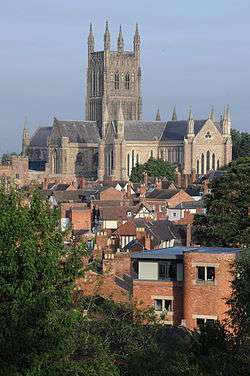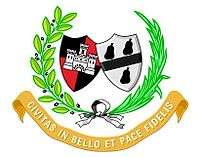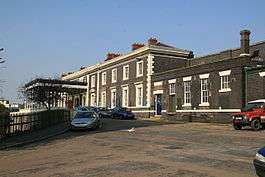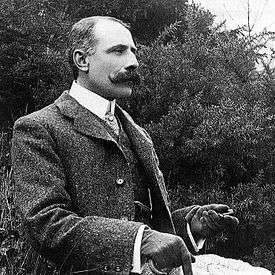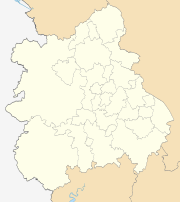Worcester
| City of Worcester | ||
|---|---|---|
| Cathedral City and non-metropolitan district | ||
|
Worcester Cathedral from Fort Royal Hill | ||
| ||
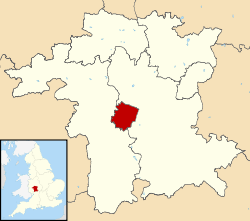 City of Worcester shown within Worcestershire | ||
| Coordinates: 52°11′28″N 2°13′20″W / 52.19123°N 2.22231°WCoordinates: 52°11′28″N 2°13′20″W / 52.19123°N 2.22231°W | ||
| Sovereign state | United Kingdom | |
| Constituent country | England | |
| Region | West Midlands | |
| Non-metropolitan county | Worcestershire | |
| Status | Non-metropolitan district, City | |
| Admin HQ | Worcester | |
| Government | ||
| • Type | Non-metropolitan district council | |
| • Borough council | Worcester City Council (Labour / Green) | |
| • MPs | Robin Walker (Conservative) | |
| Area | ||
| • Total | 12.85 sq mi (33.28 km2) | |
| Area rank | 305th (of 326) | |
| Population (mid-2015) | ||
| • Total | 101,328 | |
| • Rank | 232nd (of 326) | |
| • Density | 7,900/sq mi (3,000/km2) | |
| Time zone | GMT (UTC0) | |
| • Summer (DST) | BST (UTC+1) | |
| Postcodes | WR1-5 | |
| Area code(s) | 01905 | |
| ONS code |
47UE (ONS) E07000237 (GSS) | |
| OS grid reference | SO849548 | |
| Website |
www | |
Worcester (![]() i/ˈwʊstər/ WUUS-tər) is a Cathedral City and the county town of Worcestershire in the West Midlands of England.
i/ˈwʊstər/ WUUS-tər) is a Cathedral City and the county town of Worcestershire in the West Midlands of England.
The city is located some 17 miles (27 km) south-west of the southern suburbs of Birmingham, and 23 miles (37 km) north of Gloucester. The population is approximately 100,000. The River Severn flanks the western side of the city centre, which is overlooked by the 12th-century Worcester Cathedral.
The site of the final battle of the Civil War, Worcester was where Oliver Cromwell's New Model Army defeated King Charles I's Cavaliers, cementing the eleven-year Interregnum. Worcester was the home of Royal Worcester Porcelain, and for much of his life, the composer Sir Edward Elgar.[1] It houses the Lea & Perrins factory where traditional Worcestershire Sauce is made. The University of Worcester is one of the UK's fastest-growing universities.
History
The trade route past Worcester which later formed part of the Roman Ryknild Street dates to Neolithic times. The position commanded a ford over the River Severn (the river was tidal past Worcester prior to public works projects in the 1840s) and was fortified by the Britons around 400 BC. It would have been on the northern border of the Dobunni and probably subject to the larger communities of the Malvern hillforts.[2] The Roman settlement at the site passes unmentioned by Ptolemy's Geography, the Antonine Itinerary and the Register of Dignitaries but would have grown up on the road opened between Glevum (Gloucester) and Viroconium (Wroxeter) in the AD 40s and 50s. It may have been the "Vertis" mentioned in the 7th-century Ravenna Cosmography. Using charcoal from the Forest of Dean, the Romans operated pottery kilns and ironworks at the site[3] and may have built a small fort.[4]
In the 3rd century, Roman Worcester occupied a larger area than the subsequent medieval city, but silting of the Diglis Basin caused the abandonment of Sidbury. Industrial production ceased and the settlement contracted to a defended position along the lines of the old British fort at the river terrace's southern end.[5] This settlement is generally identified with the Cair Guiragon[6] listed among the 28 cities of Britain by the History of the Britons attributed to Nennius.[7][8] This is not a British name but an adaption of its Old English name Weorgoran ceaster, "fort of the Weorgoran". The Weorgoran (the "people of the winding river") were precursors of Hwicce and probably West Saxons who entered the area some time after the 577 Battle of Dyrham. In 680, their fort at Worcester was chosen—in preference to both the much larger Gloucester and the royal court at Winchcombe—to be the seat of a new bishopric, suggesting there was already a well-established and powerful Christian community when the site fell into English hands. The oldest known church was St Helen's, which was certainly British; the Saxon cathedral was dedicated to St Peter.[5]
The town was almost destroyed in 1041 after a rebellion against the punitive taxation of Harthacanute. During this time, the townsfolk relocated to (and at times were besieged at) the nearby Bevere Island, 2 miles upriver. The following century, the town (then better defended) was attacked several times (in 1139, 1150 and 1151) during "The Anarchy", i.e. civil war between King Stephen and Empress Matilda, daughter of Henry I. This is the background to the well-researched historical novel The Virgin in the Ice, part of Ellis Peters' "Cadfael" series, which begins with the words:
"It was early in November of 1139 that the tide of civil war, lately so sluggish and inactive, rose suddenly to wash over the city of Worcester, wash away half of its lifestock, property and women and send all those of its inhabitants who could get away in time scurrying for their lives northwards away from the marauders". (These are mentioned as having arrived from Gloucester, leaving a long lasting legacy of bitterness between the two cities.)
By late medieval times the population had grown to around 10,000 as the manufacture of cloth started to become a large local industry. The town was designated a county corporate, giving it autonomy from local government.
Worcester was the site of the Battle of Worcester (3 September 1651), when Charles II attempted to forcefully regain the crown, in the fields a little to the west and south of the city, near the village of Powick. However, Charles II was defeated and returned to his headquarters in what is now known as King Charles house in the Cornmarket, before fleeing in disguise to Boscobel House in Shropshire from where he eventually escaped to France. Worcester had supported the Parliamentary cause before the outbreak of war in 1642 but spent most of the war under Royalist occupation. After the war it cleverly used its location as the site of the final battles of the First Civil War (1646) and Third Civil War (1651) to try to mount an appeal for compensation from the new King Charles II. As part of this and not based upon any historical fact, it invented the epithet "Fidelis Civitas" (The Faithful City) and this motto has since been incorporated into the city's coat of arms.[9][10]
In 1670, the River Severn broke its banks and the subsequent flood was the worst ever seen by Worcester. A brass plate can be found on a wall on the path to the cathedral by the path along the river showing how high this flood went and other flood heights of more recent times are also shown in stone bricks. The closest flood height to what is known as The Flood of 1670 was when the Severn flooded in the torrential rains of July 2007.
The Royal Worcester Porcelain Company factory was founded by Dr John Wall in 1751, although it no longer produces goods. A handful of decorators are still employed at the factory and the Museum is still open.
During the late 18th and early 19th centuries, Worcester was a major centre for glove making, employing nearly half the glovers in England at its peak (over 30,000 people).[11] In 1815 the Worcester and Birmingham Canal opened, allowing Worcester goods to be transported to a larger conurbation.
The British Medical Association (BMA) was founded in the Board Room of the old Worcester Royal Infirmary building in Castle Street in 1832.[12] While part of the Royal Infirmary has now been demolished to make way for the University of Worcester's new city campus, the original Georgian building has been preserved.[13] One of the old wards opened as a medical museum, The Infirmary, in 2012.[14][15]
In 1882 Worcester hosted the Worcestershire Exhibition, inspired by the Great Exhibition in London.There were sections for exhibits of fine arts (over 600 paintings), historical manuscripts and industrial items.The profit was £1,867.9s.6d. The number of visitors is recorded as 222,807. Some of the profit from the exhibition was used to build the Victoria Institute in Foregate Street, Worcester. This was opened on 1 October 1896 and now houses the city art gallery and museum. Further information about the exhibition can be found at the museum.
During World War II, the city was chosen to be the seat of an evacuated government in case of mass German invasion. The War Cabinet, along with Winston Churchill and some 16.000 state workers, would have moved to Hindlip Hall (now part of the complex forming the Headquarters of West Mercia Police), 3 miles (4.8 km) north of Worcester and Parliament would have temporarily seated in Stratford-upon-Avon. The former RAF station RAF Worcester was located east of Northwick.
In the 1950s and 1960s large areas of the medieval centre of Worcester were demolished and rebuilt as a result of decisions by town planners. This was condemned by many such as Nikolaus Pevsner who described it as a "totally incomprehensible... act of self-mutilation".[16] There is still a significant area of medieval Worcester remaining, but it is a small fraction of what was present before the redevelopments.
The current city boundaries date from 1974, when the Local Government Act 1972 transferred the parishes of Warndon and St. Peter the Great County into the city.
Images
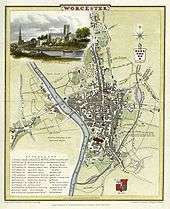 A map of Worcester in 1806 |
Tudor buildings in Friar Street |
Tudor building with jettied upper storey in New Street |
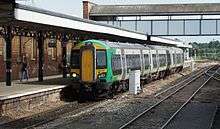 Worcester Shrub Hill railway station with a London Midland train. |
Governance
The Conservatives had a majority on the council from 2003 to 2007, when they lost a by-election to Labour meaning the council had no overall control.[17] The Conservatives remained with the most seats overall with 17 out of 35 seats after the 2008 election.[18]
Worcester has one member of Parliament, Robin Walker of the Conservative Party, who represents the Worcester constituency as of the May 2010 general election.[19]
The County of Worcestershire's local government arrangement is formed of a non-metropolitan county council (Worcestershire County Council) and six non-metropolitan district councils, with Worcester City Council being the district council for most of Worcester, with a small area of the St. Peters suburb actually falling within the neighbouring Wychavon District council. The Worcester City Council area includes two parish councils, these being Warndon Parish Council and St Peter the Great Parish Council.

Worcester Guildhall, the seat of local government, dates from 1721; it replaced an earlier hall on the same site. The Grade I listed Queen Anne style building is described by Pevsner as 'a splendid town hall, as splendid as any of C18 England'.[20]
Geography
Notable suburbs in Worcester include Barbourne, Blackpole, Cherry Orchard, Claines, Diglis, Northwick, Red Hill, Ronkswood, St Peter the Great (also simply known as St Peters), Tolladine, Warndon and Warndon Villages (which was once the largest housing development in the Country when the area was being constructed in the late 1980s/very early 1990s). Most of Worcester is on the eastern side of the River Severn; Henwick, Lower Wick, St. John's and Dines Green are on the western side.
Climate
Worcester enjoys a temperate climate with warm summers and mild winters generally. However, the city can experience more extreme weather and flooding is often a problem.[21] During the winters of 2009-10 and 2010-11 the city experienced prolonged periods of sub-freezing temperatures and heavy snowfalls. In December 2010 the temperature dropped to −19.5 °C (−3.1 °F) in nearby Pershore.[22] The River Severn and the River Teme partially froze over in Worcester during this cold snap. In contrast, Worcester recorded 37 °C (98.6 °F) on 3 August 1990.[21]
Between 1990 and 2003, weather data for the area was collected at Barbourne, Worcester. After the closure of this weather station, the nearest one is located at Pershore.[23]
| Climate data for Worcester | |||||||||||||
|---|---|---|---|---|---|---|---|---|---|---|---|---|---|
| Month | Jan | Feb | Mar | Apr | May | Jun | Jul | Aug | Sep | Oct | Nov | Dec | Year |
| Record high °C (°F) | 17.1 (62.8) |
19.6 (67.3) |
21.0 (69.8) |
26.6 (79.9) |
28.2 (82.8) |
33.1 (91.6) |
33.8 (92.8) |
37.0 (98.6) |
28.8 (83.8) |
28.4 (83.1) |
18.6 (65.5) |
15.9 (60.6) |
37.0 (98.6) |
| Average high °C (°F) | 7 (45) |
8 (46) |
11 (52) |
14 (57) |
17 (63) |
20 (68) |
22 (72) |
22 (72) |
19 (66) |
15 (59) |
10 (50) |
8 (46) |
14.4 (58) |
| Average low °C (°F) | 2 (36) |
1 (34) |
3 (37) |
4 (39) |
7 (45) |
10 (50) |
12 (54) |
12 (54) |
10 (50) |
7 (45) |
4 (39) |
2 (36) |
6.2 (43.3) |
| Record low °C (°F) | −14.1 (6.6) |
−12.7 (9.1) |
−9.4 (15.1) |
−7.3 (18.9) |
−2.3 (27.9) |
−1.0 (30.2) |
2.8 (37) |
3.6 (38.5) |
−0.6 (30.9) |
−5.1 (22.8) |
−10.5 (13.1) |
−19.5 (−3.1) |
−19.5 (−3.1) |
| Average rainfall mm (inches) | 53 (2.09) |
31 (1.22) |
31 (1.22) |
42 (1.65) |
47 (1.85) |
48 (1.89) |
50 (1.97) |
53 (2.09) |
48 (1.89) |
56 (2.2) |
54 (2.13) |
50 (1.97) |
563 (22.17) |
| Source #1: [24] | |||||||||||||
| Source #2: Barbourne and Pershore extremes (nearest stations)[23] | |||||||||||||

Demography and religion
The 2001 census[25] recorded Worcester's population at 93,353. About 96.5% of Worcester's population was white; of which 94.2% were White British,[26] greater than the national average.[27] The largest religious group are Christians, who made up 77% of the city's population.[28] People who reported having no religion or who did not state their religion made up 21% of the city's population. Other religions totaled less than 2% of the population. Ethnic minorities include people of Bangladeshi, Chinese, Indian, Pakistani, Italian and Polish origin, with the largest single minority group being British Pakistanis, numbering around 1,200, approximately 1.3% of Worcester's population.[28] This has led to Worcester containing a small but diverse range of religious groups; as well as the commanding Worcester Cathedral (Church of England), there are also Catholic, United Reformed Church [29] and Baptist churches, a large center for The Church of Jesus Christ of Latter-day Saints (LDS Church), an Islamic mosque and a number of smaller interest groups regarding Eastern Religions such as Buddhism and the Hare Krishnas.[30]
Worcester is the seat of a Church of England bishop. His or her official signature is his or her Christian name followed by Wigorn. (an abbreviation for the Latin Wigorniensis, meaning 'of Worcester'),[31] which is also occasionally used as an abbreviation for the name of the county.
The Archdeacon of Worcester, inducted in November 2014, was Rector of St. Barnabas with Christ Church in Worcester for eight years.
Economy
The city of Worcester, located on the River Severn and with transport links to Birmingham and other parts of the Midlands through the vast canal network, became an important centre for many light industries. The late-Victorian period saw the growth of ironfounders, like Heenan & Froude, Hardy & Padmore and McKenzie & Holland.
Glove industry
One of the flourishing industries of Worcester was glove making. Worcester's Gloving industry peaked between 1790 and 1820 when about 30,000 were employed by 150 companies. At this time nearly half of the Glove manufacturers of Britain were located in Worcestershire.
In the 19th century the industry declined because import taxes on foreign competitors, mainly from France, were greatly reduced.
By the middle of the 20th century, only a few Worcester gloving companies survived since gloves became less fashionable and free trade allowed in cheaper imports from the Far East.
Nevertheless, at least 3 large glove manufacturing companies still survived until the late 20th century: Dent Allcroft, Fownes and Milore. Queen Elizabeth II's coronation gloves were designed by Emil Rich and manufactured in the Worcester-based Milore factory.[32][33]
Manufacturing

The inter-war years saw the rapid growth of engineering, producing machine tools James Archdale, H.W. Ward, castings for the motor industry Worcester Windshields and Casements, mining machinery Mining Engineering Company (MECO) which later became part of Joy Mining Machinery and open-top cans Williamsons, though G H Williamson and Sons had become part of the Metal Box Co in 1930. Later the company became Carnaud Metal Box PLC.
Worcester Porcelain operated in Worcester until 2008, when the factory closed down due to the recession. However, the site of Worcester Porcelain still houses the Museum of Royal Worcester which is open daily to visitors.[34]
One of Worcester's most famous products, Lea & Perrins Worcestershire sauce is made and bottled at the Midland Road factory in Worcester, which has been the home of Lea & Perrins since 16 October 1897. Mr Lea and Mr Perrins originally met in a chemist's shop on the site of the now Debenhams store in the Crowngate Shopping Centre.
The surprising foundry heritage of the city is represented by Morganite Crucible[35] at Norton which produces graphitic shaped products and cements for use in the modern industry.
Worcester is the home of what is claimed to be the oldest newspaper in the world, Berrow's Worcester Journal, which traces its descent from a news-sheet that started publication in 1690. The city is also a major retail centre with several covered shopping centres that has most major chains represented as well as a host of independent shops and restaurants, particularly in Friar Street and New Street.
The city is home to the European manufacturing plant of Yamazaki Mazak Corporation, a global Japanese machine tool builder, which was established in 1980.[36]
Retail trade
The Kays mail order business was founded in Worcester in the 1880s and operated from numerous premises in the city until 2007. It was then bought out by Reality, owner of the Grattan catalogue. Kays' former warehouse building was demolished in 2008.[37]
Worcester's main shopping centre is the High Street, home to the stores of a number of major retail chains. Part of the High Street was modernised in 2005 amid much controversy. Many of the issues focussed on the felling of old trees, the duration of the works (caused by the weather and an archaeological find) and the removal of flagstones outside the city's 18th-century Guildhall. The other main thoroughfares are The Shambles and Broad Street, while The Cross (and its immediate surrounding area) is the city's financial centre and location of the majority of Worcester's main bank branches.
There are three main covered shopping centres in the city centre, these being CrownGate Shopping Centre, Cathedral Plaza and Reindeer Court. There is also an unenclosed shopping area located immediately east of the city centre called St. Martin's Quarter. There are three retail parks, the Elgar and Blackpole Retail Parks, which are located in the inner suburb of Blackpole and the Shrub Hill Retail Park neighbouring St. Martin's Quarter.
Landmarks
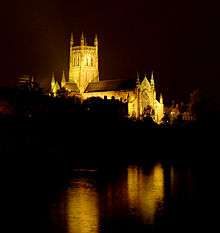
The most famous landmark in Worcester is its imposing Anglican Cathedral. The current building; known as Worcester Priory before the English Reformation, is officially named The Cathedral Church of Christ and the Blessed Virgin Mary. Construction begun in 1084 while its crypt dates from the 10th century. The chapter house is the only circular one in the country while the cathedral also has the distinction of having the tomb of King John.
Limited parts of Worcester's city wall still remain in situ.
The Hive, situated on the northern side of the River Severn at the former cattle market site, is Worcester's joint public and university library and archive centre, heralded as "the first of its kind in Europe". It is a prominent landmark feature on the Worcester skyline. With seven towers and a golden rooftop, The Hive has gained recognition winning two international awards[38][39] for building design and sustainability.
There are three main parks in Worcester, Cripplegate Park, Gheluvelt Park and Fort Royal Park, the latter being on one of the battles sites of the English Civil War. In addition, there is a large open area known as Pitchcroft to the North of the city centre on the east bank of the River Severn, which, apart from those days when it is being used for horse racing, is a public space.
Gheluvelt Park was opened as a memorial to commemorate the Worcestershire Regiment's 2nd Battalion after their part in the Battle of Gheluvelt, during the First World War.[40]
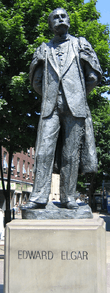
The statue of Sir Edward Elgar, commissioned from Kenneth Potts and unveiled in 1981, stands at the end of Worcester High Street facing the Cathedral, only yards from the original location of his father's music shop, which was demolished in the 1960s.[41] Elgar's birthplace is a short way from Worcester, in the village of Broadheath.
There are also two large woodlands in the city, Perry Wood, at twelve hectares and Nunnery Wood, covering twenty-one hectares. Perry Wood is often said to be the place where Oliver Cromwell met and made a pact with the devil.[42] Nunnery Wood is an integral part of the adjacent and popular Worcester Woods Country Park, itself next door to County Hall on the east side of the city.
Transport
Road
The M5 Motorway runs north-south immediately to the east of the City and is accessed by Junction 6 (Worcester North) and Junction 7 (Worcester South). This makes the city easily accessible by car to most parts of the country, including London which is only 118 miles (190 km) using the A44 via the Cotswolds and M40. A faster journey to London is possible via the M5, M42 and M40 for an increased distance of 134 miles (216 km).
Several A roads pass through the city. The A449 road runs south-west to Malvern and north to Kidderminster. The A44 runs south-east to Evesham and west to Leominster and Aberystwyth and crosses Worcester Bridge. The A38 trunk road runs south to Tewkesbury and Gloucester and north-north-east to Droitwich and Birmingham. The A4103 goes west-south-west to Hereford. The A422 heads east to Alcester, branching from the A44 a mile east of the M5. The city is encompassed by a partial ring road (A4440) which is formed, rather inconsistently, by single and dual carriageways. The A4440 road provides a second road bridge across the Severn (Carrington Bridge) just west of the A4440-A38 junction. Carrington Bridge links the A38 from Worcester towards Gloucester with the A449 linking Worcester with through Malvern.
Rail

Worcester has two stations, Worcester Foregate Street and Worcester Shrub Hill.
Worcester Foregate Street is located in the city centre, on Foregate Street. The line towards Malvern and Hereford, which is the Cotswold Line, crosses Foregate Street on an arched cast-iron bridge which was remodelled by the Great Western Railway in 1908 with decorative cast-iron exterior serving no structural purpose.[43] Between Foregate Street and the St. John's area of the city, heading towards Malvern and Hereford, the line is elevated and travels along the Worcester viaduct which crosses over the River Severn.
Worcester Shrub Hill is located around one mile from the city centre on Shrub Hill Road. The station is part of a loop line off the Birmingham to Gloucester railway, which forms part of today's crosscountry route.
Alongside the Worcester Shrub Hill station, on Shrub Hill Road, was the Worcester Engine Works. The polychrome brick building was erected about 1864 and was probably designed by Thomas Dickson. The venture was not a success and only 84 locomotives were built and the works closed in 1871.[44] The chairman of the Worcester Engine Works was Alexander Clunes Sheriff.
Both stations frequently serve Birmingham via Droitwich Spa, then either lines being firstly via Kidderminster and Stourbridge into Birmingham Snow Hill and Birmingham Moor Street then onwards usually to Dorridge or Whitlocks End or secondly via Bromsgrove and University and Birmingham New Street these services are run by London Midland.
Bus
The main operator of bus services in and around the city is First Midland Red. A few other smaller operators provide services in Worcester, including; Astons, DRM and LMS Travel. The terminus and interchange for many bus services in Worcester is Crowngate Bus Station located in the city centre.
The city formerly had two park and ride sites, one located off the A38 in Perdiswell (opened in 2001) and the other at Sixways Stadium next to the M5 (opened 2009). Worcestershire County Council voted to close both of them in 2014 as part of a cost-saving package of cutbacks to bus services.[45]
The park and ride service at Sixways Stadium has since been reinstated, with LMS Travel operating the W3 route to Worcestershire Royal Hospital. The route does not service Worcester's city centre bus station.[46]
Air
Worcester's nearest major airport is Birmingham Airport which is accessible by road and rail. Gloucestershire Airport is approximately 25 miles away and provides General Aviation connections and scheduled services with Citywing to Jersey, the Isle of Man and Belfast.
Education
Worcester is home to the University of Worcester, which was awarded university status in 2005 by HM Privy Council. From 1997 to 2005 it was known as University College Worcester (UCW) and prior to 1997 it was known as Worcester College of Higher Education. From 2005 to 2010 it was the fastest growing university in the UK, more than doubling its student population. The University is also home to the independent Worcester Students Union institution. The city is also home to two colleges, Worcester Sixth Form College and Heart of Worcestershire College.
High schools
The high schools located in the city are Bishop Perowne CofE College, Blessed Edward Oldcorne Catholic College, Christopher Whitehead Language College, Tudor Grange Academy Worcester (on the site of the defunct Elgar High School), Nunnery Wood High School and New College Worcester which caters for blind and partially sighted pupils from the ages of 11 to 18.
Independent schools
Worcester is also the seat of three independent schools. The Royal Grammar School, founded in 1291 and Alice Ottley School merged in 2007. The King's School was re-founded in 1541 under King Henry VIII. St Mary's School, a girls' Catholic school, was the only remaining single-sex independent school, but closed in July 2014. Other independent schools include the Independent Christian school, the River School in Fernhill Heath, and New College Worcester for the blind and partially sighted.
Sport
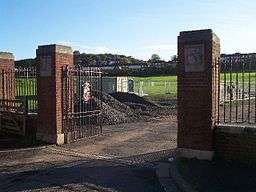
- Worcester Warriors, an Aviva Premiership Rugby Union team who play at Sixways Stadium.
- Worcestershire County Cricket Club whose home ground is New Road.
- National League North football club Worcester City (The team currently plays at Aggborough in Kidderminster)
- Worcester Hockey Club has teams entered in the West Hockey Leagues.[47]
- Worcester St Johns Cycling Club
- Worcester Wolves, a professional basketball team in the British Basketball League.
- Worcester Racecourse is on an open area known as "Pitchcroft" on the east bank of the River Severn.
- Worcester has King George's Field in memorial to King George V.
- Worcester Rowing Club which is situated near the city centre on the River Severn.
- University of Worcester Rowing Club which shares accommodation with Worcester Rowing Club.
- University of Birmingham Rowing Club
- Worcester Athletics Club who meet on Tuesdays and Thursdays at Nunnery Wood Sports Centre
- Worcester University Climbing and Mountaineering Club
- Worcester Dominies and Guild Cricket Club
- Kempsey Cricket Club
Culture
Festivals and shows
Every three years Worcester becomes home to the Three Choirs Festival, which dates from the 18th century and is credited with being the oldest music festival in the British Isles. The location of the festival rotates each year between the Cathedral Cities of the Three Counties, Gloucester, Hereford and Worcester. Famous for its championing of English music, especially that of Elgar, Vaughan Williams and Gustav Holst, Worcester was host of the festival in July 2014.[48]
The Worcester Festival was established in 2003 by Chris Jaeger MBE. Held in August, the festival consists of a variety of music, theatre, cinema and workshops, as well as the already established Beer Festival, which runs as an event within the Worcester Festival.[49] Worcester Festival ends with a spectacular free firework display on the banks of the River Severn on the Monday of the August bank holiday. The Artistic Director of the Worcester Festival is now actor, director and writer, Ben Humphrey.
For one weekend the city plays host to the Worcester Music Festival. Now in its 8th year (2015) the festival comprises a weekend of original music performed by predominantly local bands and musicians. All performances are free and take place throughout the city centre: in bars, clubs, community buildings, churches and the central library. In 2010 the festival comprised 230 different acts. The 2015 Festival will take place between 18 and 20 September.
Founded in 2012, the Worcester Film festival, is all about placing Worcestershire on the film-making map and encouraging local people to get involved in making film. The first festival took place at the Hive and including screenings, workshops and talks.[50]
The Victorian-themed Christmas Fayre is a major source of tourism every December.[51] Elton John came to the Worcestershire Cricket Ground, New Road on Saturday 9 June 2006. Status Quo came to Sixways Stadium (Worcester Warriors) on Saturday 28 July 2007.
The CAMRA Worcester Beer, Cider and Perry festival takes place for three days each August [52] and is held on Pitchcroft Race Course. This festival is the largest beer festival within the West Midlands and within the top 10 in the United Kingdom with attendances being around 14,000 people.[53]
2015 will see the first Worcester Canal Festival, held at Lansdowne Park from the 12 to 14 June, to celebrate the 200th Anniversary of the Worcester & Birmingham Canal.
Arts and cinema

Famous 18th-century actress Sarah Siddons made her acting début here at the Theatre Royal in Angel Street. Her sister, the novelist Ann Julia Kemble Hatton, otherwise known as Ann of Swansea, was born in the city.[54] Matilda Alice Powles, better known as Vesta Tilley, a leading male impersonator and music hall artiste was born in Worcester.[55]
In present-day Worcester the Swan Theatre[56] stages a mixture of professional touring and local amateur productions. It is also home to the Worcester Repertory Company. Past Artistic Directors of the Worcester Repertory Company (and by default The Swan Theatre) have included John Doyle and David Wood OBE. The company's (and theatre's) current Artistic Director is Chris Jaeger MBE.
A number of 'stars' started their careers in the Worcester Repertory Company and the Swan Theatre. Imelda Staunton, Sean Pertwee, Celia Imrie, Rufus Norris, Kevin Whately and Bonnie Langford were all actors with the Rep at the start of their careers. Directors too have made a name for themselves with Phyllida Lloyd starting her directorial career as an Associate Director under John Doyle, a position that is now filled by Ben Humphrey.
The Countess of Huntingdon's Hall is a historic church now used as venue for an eclectic range of musical and comedy performances,.[56] Recent acts have included Van Morrison, Eddie Izzard, Jack Dee, Omid Djalili and Jason Manford.
The Marrs Bar is a venue for gigs and stand-up comedy.[57] Worcester has two multi-screen cinemas; a Vue Cinema complex located on Friar Street and an Odeon Cinema on Foregate Street – both of which were 3D-equipped by March 2010.
In the northern suburb of Northwick is the Art Deco Northwick Cinema. Built in 1938 it contains one of the only two remaining interiors in Britain designed by John Alexander (the original perspective drawings are still held by RIBA). It was a bingo hall from 1966 to 1982 and then empty until 1991; it was then run as a music venue until 1996 and was empty again until autumn 2006 when it became an antiques and lifestyle centre, owned by Grey's Interiors, who were previously located in the Tything.[58]
Worcester was home to electronic music producer and collaborator Mike Paradinas and his record label Planet Mu, until the label moved to London in 2007.
Media
Newspapers
- Berrow's Worcester Journal
- Worcester News
- Worcester Observer
Radio Stations
Twinning and planned twinning
Worcester is twinned with the German city of Kleve, the Parisian commune of Le Vésinet and its larger American namesake Worcester, Massachusetts.[59]
In February 2009 Worcester City Council's Twinning Association began deliberating an application to twin Worcester with the Palestinian city of Gaza. Councillor Alan Amos introduced the application, which was passed at its first stage by a majority of 35-6.[60] The proposal was later rejected by the Executive Committee of the City of Worcester Twinning Association for lack of funding due to its present commitment to existing twinning projects.[61]
Notable people
In birth order:
- Hannah Snell (1723–1792), famous for impersonating a man and enlisting in the Royal Marines, was born and brought up in Worcester.
- Elizabeth Blower (c. 1757/63 – post-1816), novelist, poet and actress, was born and raised in Worcester.
- Ann Hatton (1764–1838), writer of the Kemble family, was born in Worcester.
- James White (1775–1820), founder of first advertising agency in 1800 in London, was born in Worcester.
- John Mathew Gutch (1776–1861), journalist, lived with his second wife at Barbourne, a suburb north of Worcester, from 1823 until his death.
- Jabez Allies (1787–1856) a Worcestershire folklorist and antiquarian lived at Lower Wick, now part of Worcester.
- Sir Charles Hastings (1794–1866), British Medical Association founder, lived in Worcester for most of his life.
- Revd Thomas Davis, a hymn-writer born in Worcester in 1804, was an ancestor of the Duchess of Cambridge.
- Philip Henry Gosse, naturalist, was born in Worcester in 1810.
- Mrs. Henry Wood (1814–1887), writer, was born in Worcester.
- Alexander Clunes Sheriff (1816–1878), City Alderman, businessman and Liberal MP, grew up in Worcester.
- Edward Leader Williams (1828–1910), designer of the Manchester Ship Canal, was born and brought up at Diglis House in Worcester, with his brother, landscape artist Benjamin Williams Leader (1831–1923).
- Sir Thomas Brock (1847–1922), sculptor, best known for the Victoria Memorial (London), was born in Worcester in 1847. Worcestershire Royal Hospital is in a road named after him.
- Vesta Tilley (1864–1952), music hall performer who adopted this stage name aged 11, was born in Worcester. She became a noted male impersonator.
- Composer Sir Edward Elgar's father ran a music shop in High Street; a statue of Elgar stands near the original site. He was born in 1857 is in Broadheath, outside Worcester.
- William Morris, Lord Nuffield (1877–1963), founder of Morris Motors Limited and philanthropist, spent the first three years in Worcester.
- Geoffrey Anketell Studdert Kennedy (1883–1929, "Woodbine Willy"), poet and author, was Vicar of St Paul's Church. As an army chaplain in World War I he would hand out Woodbine cigarettes to men in the trenches.
- Ernest Payne (1884–1961) was born in Worcester and rode for St Johns Cycling Club, winning a gold medal in team pursuit at the 1908 Summer Olympics in London.
- Sheila Scott (1922–1988), aviator, was born in Worcester.
- Louise Johnson (1940–2012), biochemist and protein crystallographer, was born in Worcester.[62]
- Timothy Garden, Baron Garden (1944–2007), Air Marshal and Liberal Democrat politician, was born in Worcester.
- Dave Mason (born 1946), musician, singer, songwriter and guitarist, was born in Worcester.
- Lee Cornes (born 1951), comedian and actor known for roles in Blackadder, The Young Ones and Bottom, was born in Worcester.
- David McGreavy (born 1951, the "Monster of Worcester"), lived and committed child murders in Worcester.
- Stephen Dorrell (born 1952), English Conservative politician and government member, was born in Worcester.
- Karl Hyde (born 1957), English musician, frontman of popular trance group Underworld was born in Worcester.
- Kit Harington (born 1986), actor, lived in Worcester attended Chantry High School and Worcester Sixth Form College. He played Jon Snow in Game of Thrones.
- Andrew Hung and Benjamin John Power of experimental music group Fuck Buttons were brought up in Worcester.
- Peace (band), an Indie Rock band formed in Worcester in 2009 and fronted by Harry Koisser, were nominees for the BBC's Sound Of 2013 poll.
See also
References
- ↑ The Elgar Trail. ELGAR. Retrieved on 2 August 2013.
- ↑ City of Worcester. "The First Settlers". Worcester City Council (Worcester), 2005.
- ↑ City of Worcester. "Vertis—The Roman Industrial Town, 1st–4th centuries A.D." Worcester City Council (Worcester), 2005.
- ↑ Roman Britain. "Vertis".
- 1 2 City of Worcester. "The Late Roman and Post-Roman Settlement, 4th Century A.D.–A.D. 680". Worcester City Council (Worcester), 2005.
- ↑ Nennius (attrib.). Theodor Mommsen (ed.). Historia Brittonum, VI. Composed after AD 830. (Latin) Hosted at Latin Wikisource.
- ↑ Ford, David Nash. "The 28 Cities of Britain" at Britannia. 2000.
- ↑ Newman, John Henry & al. Lives of the English Saints: St. German, Bishop of Auxerre, Ch. X: "Britain in 429, A. D.", p. 92. James Toovey (London), 1844.
- ↑ "Civic Heralrdy of England and Wales – Severn Valley and the Marches". civicheraldry.co.uk. Retrieved 8 January 2013.
- ↑ Atkin, Malcolm (1998). Cromwell's Crowning Mercy: The Battle of Worcester 1651. Barnsley: Pen and Sword. pp. 158–9. ISBN 0-7509-1888-8.
- ↑ "Worcester glove-making". BBC. Retrieved 18 January 2011.
- ↑ "BMA – Our history". British Medical Association. Retrieved 8 January 2013.
- ↑ "University demolition work starts". BBC News. 3 January 2008. Retrieved 26 January 2010.
- ↑ University of Worcester, The Infirmary
- ↑ "History of Worcester Royal Infirmary to Be Brought Back to Life". University of Worcester. 5 November 2009. Retrieved 8 January 2013.
- ↑ The Buildings of England – Worcester, Penguin, 1968
- ↑ Lauren Rogers (21 September 2007). "Beaten Tory Keeps A Low Profile". Worcester News.
- ↑ "Election 2008 Worcester council". BBC News Online. 19 April 2008. Retrieved 8 January 2010.
- ↑ "Michael Foster: Electoral history and profile". The Guardian. London. Retrieved 8 January 2010.
- ↑ Guildhall – Worcester – Worcestershire – England. British Listed Buildings. Retrieved on 2 August 2013.
- 1 2 "Extreme weather in Herefordshire and Worcestershire". BBC. 20 September 2010. Retrieved 12 January 2012.
- ↑ Hill, Amelia (20 December 2010). "Chill record: Worcester town Pershore encounters drop to -19C". The Guardian. London. Retrieved 14 January 2012.
- 1 2 http://en.tutiempo.net/climate/united-kingdom.html
- ↑ "Averages for Worcester". msn.
- ↑ "Census 2001 – Profiles – Worcester". Statistics.gov.uk. 13 February 2003. Archived from the original on 29 June 2011. Retrieved 27 September 2010.
- ↑ "Worcester Town Profile" (PDF).
- ↑ "National Statistics Online – Population Size". Statistics.gov.uk. 8 January 2004. Archived from the original on 29 July 2010. Retrieved 27 September 2010.
- 1 2 "Census 2001 – Profiles – Worcester". Statistics.gov.uk. 13 February 2003. Archived from the original on 29 June 2011. Retrieved 27 September 2010.
- ↑ Worcester United Reformed Church official website
- ↑ "The 'Hare Krishna' movement". BBC Hereford & Worcester. 12 July 2006. Retrieved 8 January 2013.
- ↑ Chambers Dictionary, 12th edition.
- ↑ "Spirit of Enterprise Exhibition – Glove Making". Worcester Museums and Galleries.
- ↑ Michael Grundy (21 June 2010). "This week in 1980". Worcester News. Retrieved 8 January 2013.
- ↑ "Worcester Porcelain Museum". Worcester Porcelain Museum. Retrieved 27 September 2010.
- ↑ Morganite Crucible Archived 1 August 2015 at the Wayback Machine.
- ↑ "Mazak History". Yamazaki Mazak Corporation. Retrieved 29 March 2015.
- ↑ "Kays Heritage Group". Kays Heritage Group. 19 May 2012. Retrieved 8 January 2013.
- ↑ "National Sustainability Award". June 2012.
- ↑ "CIBSE Building Performance Awards". 2013.
- ↑ "Worcester's Gheluvelt Park given listed status". 2015.
- ↑ "no 10, the Elgar Brothers' music shop. Its location is commemorated in a plaque on a shop front unveiled in 2003." (PDF). The Elgar Route – A walk around Elgar's Worcester. Visitworcestershire.org.
- ↑ Fraser, Antonia (1973). Cromwell Our Chief of Men. p. 387. ISBN 0-09-942756-7.
- ↑ Richard Morriss The Archaeology of Railways, 1999 Tempus Publishing,Stroud. p89
- ↑ Richard Morriss The Archaeology of Railways, 1999 Tempus Publishing, Stroud. Plate 93 p147
- ↑ County council leadership votes through park and ride axe, Worcester News, 10 June 2014.
- ↑ "Worcester Park and Ride". Worcestershire County Council. 2016.
- ↑ "Worcester Hockey Club". worcesterhockey.co.uk. Retrieved 17 October 2014.
- ↑ "Three Choirs Festival – Programme & Tickets". Retrieved 18 July 2014.
- ↑ "Worcester Festival". Retrieved 18 July 2014.
- ↑ 'New talent to shine' Worcester Standard. 1 November 2012. Retrieved 16 September 2013.
- ↑ "Worcester's Victorian Christmas Fayre". Worcester News. 28 November 2012. Retrieved 18 July 2014.
- ↑ "2012 Worcester Beer, Cider and Perry Festival". Worcester Beer, Cider and Perry Festival. Retrieved 8 January 2013.
- ↑ James Connell (15 August 2011). "Cheers! Beer festival is the biggest and best yet". Worcester News. Retrieved 8 January 2013.
- ↑ "Ann Julia Kemble Hatton (1764-1848)". Literary Heritage West Midlands. Retrieved 8 January 2013.
- ↑ Maitland, Sarah (1986). Vesta Tilley. London, UK: Virago Press. p. 14. ISBN 0-86068-795-3.
- 1 2 "About Us Worcester Live". Worcester Live. Retrieved 8 January 2013.
- ↑ "Marr's Bar". Marr's Bar. 30 August 2012. Retrieved 8 January 2013.
- ↑ "Royal Institute of British Architects". Royal Institute of British Architects. Retrieved 7 January 2013.
- ↑ Lauren Rogers (31 January 2008). "City to fight US twin 'snub'". Worcester News.
- ↑ Richard Vernalls (26 February 2009). "Worcester could be twinned with Gaza City". Worcester News. Retrieved 27 February 2009.
- ↑ James Connell (10 March 2009). "Gaza twinning the decision is in". Worcester News. Retrieved 9 July 2009.
- ↑ ODNB entry retrieved 21 February 2016
Further reading
- John Britton; et al. (1814), "City of Worcester", Worcestershire, Beauties of England and Wales, 15, London: J. Harris
- "Worcester", Black's Picturesque Tourist and Road-book of England and Wales (3rd ed.), Edinburgh: Adam and Charles Black, 1853
- "Worcester", Great Britain (4th ed.), Leipsic: Karl Baedeker, 1897, OCLC 6430424
- Atkin, Malcolm (1998). Cromwell's Crowning Mercy: The Battle of Worcester 1651. Barnsley: Pen and Sword. ISBN 0-7509-1888-8.
- Baker, Nigel; Holt, Richard (1996). "The City of Worcester in the Tenth Century". In Brooks, Nicholas; Cubitt, Catherine. St. Oswald of Worcester : Life and Influence. London, UK: Leicester University Press. ISBN 9780567340313.
External links
![]() Media related to Worcester at Wikimedia Commons
Media related to Worcester at Wikimedia Commons
| Wikisource has the text of a 1911 Encyclopædia Britannica article about Worcester. |
| Wikivoyage has a travel guide for Worcester. |
